The grounds of Middle Temple are a quiet sanctuary off a busy Fleet Street. Nestled within the surroundings of Fountain Court is the Inn’s fountain, which has stood there since its original construction in 1681. When erected, it is considered to have been, at the time of its construction, the first permanent water fountain in London, said to shoot jets of water up to thirty feet in the air. This month we will be using the records in the archive to look at the history of the fountain at the Inn.
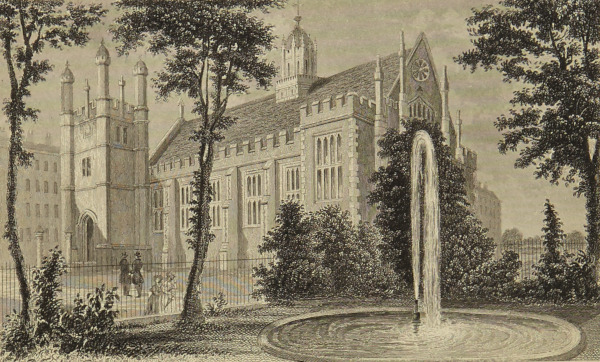
Middle Temple Fountain, c.1830-c.1850 [MT/19/ILL/D/D1/11].
The fountain was built on land that had been donated to the Inn five years prior and was originally 21 feet in diameter and 4 feet deep. It appears that it gained admirers very early on, as evidenced by a 1683 petition to Parliament from a Mr J. Hulker asking if the windows of his chamber which faced towards the fountain could be enlarged - quite possibly for a better view of the new fountain!
Every fountain requires a good source of water to produce its jet stream, especially one as impressive as the Temple fountain’s which, according to The New View London in 1708, forced itself to “a vast almost incredible altitude.” The fountain’s water was supplied by the New River Company from whom numerous bills survive in the Archive.
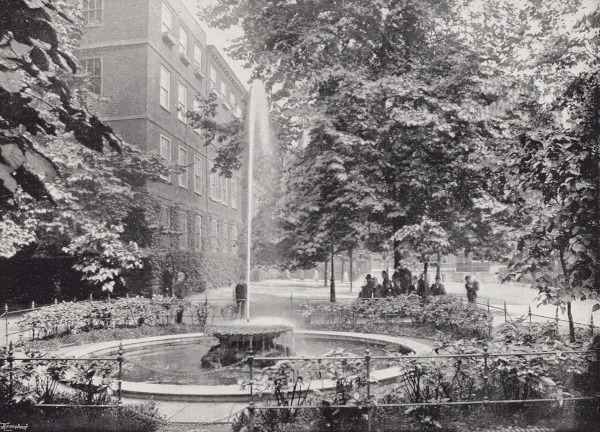
Middle Temple Fountain, 1896 [MT/19/ILL/E/E4/25].
A memorandum of agreement was written up between the New River Company and Middle Temple in 1856 which stated that the fountain should be monitored by its own meter, with the water charged at a rate of sixpence per thousand gallons per annum. There was also a clause which stated that in order to reduce the costs and supplies needed for the fountain, it was to be closed “during the night and…during the dead and winter seasons.”
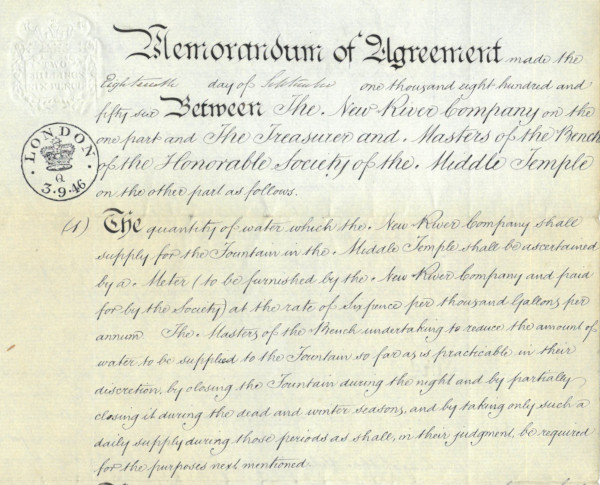
New River Company and Middle Temple Memorandum of Agreement [MT/6/RBW/186].
The fountain was initially surrounded by oak palisades; however, these were replaced in 1715 following a petition launched by a Mr Thomas Robinson who asked for “the setting up of iron rails or a fence about the fountain.” This appeal was approved by the Treasurer who contracted workmen to complete it at the cost of £50. These railings can be seen in the 1738 painting by Joseph Nickolls titled The Fountain in the Temple which currently hangs in the Prince’s Room at the Inn. The view shows the iron railings which surrounded the fountain at the time, with a small garden area consisting of grass, flowers and trees placed around it.
Painting of Fountain Court by Joseph Nickolls.
However, having gated access to the fountain sometimes came to cause conflict between residents and staff at the Inn. For example, in the 1700’s, a hosier named Mr William Brown wrote a petition to the Inn’s Parliament regarding access to the fountain.
Mr Brown stated that he had purchased a key from the society to open the gate for access to the fountain, which was then borrowed by the Society’s Gardener, Mr Clayton. Unfortunately, Mr Clayton then refused to return the key and put a chain on the gate, thereby “utterly debarring your petitioner [Brown] from fetching water from the fountain.” Brown went further to state that it is of “great inconvenience as well as expense…to be obliged to fetch water at any greater distance than the said fountain.”
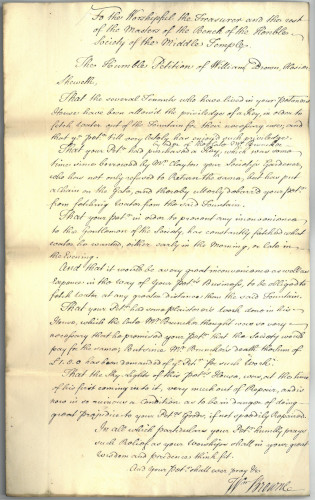
William Brown Petition [Box XIII-Bundle IX -19].
Being such a feature in the grounds of Middle Temple and Fountain Court, the fountain was placed under the jurisdiction of the gardener who was responsible for attending to and maintaining it. The archives hold many receipts for the garden, many of which include reference to plants/foliage purchased to surround the fountain. For example, in November 1804, 4 shillings and 6 pence were spent on an “elm tree for the fountain” and later, in June 1882, “17 pots of Irish Ivey for the fountain” was purchased at 1 pound and 14 shillings.
Planting around the fountain also occurred as part of the Inn’s celebrations of Queen Victoria’s Diamond Jubilee when four black mulberry trees were planted around the base of the fountain basin. By the 1970s, two of these had been removed, but two mulberries survive near the fountain today, both leaning on supports but in good health!
Photo of Fountain Court, 2022.
Although the fountain was a key feature of life around the Inn, there was a time, in 1857, when its future was thrown into doubt. The Inn required the building of a new library and lecture hall on site, and it was proposed that the fountain be removed in order to allow room for this development.
However, this met with such opposition that the saga ended up being reported in the press. On the 6 March 1857, the Lincolnshire Chronicle reported that “we are to lose the only fountain in London that really did its work, and was a pleasant fountain withal, rich with many dramatic associations.”
Thankfully, due to protests and petitions from the Inn’s students and members, a different location was decided upon for the construction of the new Library, and the fountain remained in place. However, over the years since, the fountain has undergone numerous adaptations and renovations – starting in 1861, to coincide with the Inn’s celebrations of the completion of its new Library.
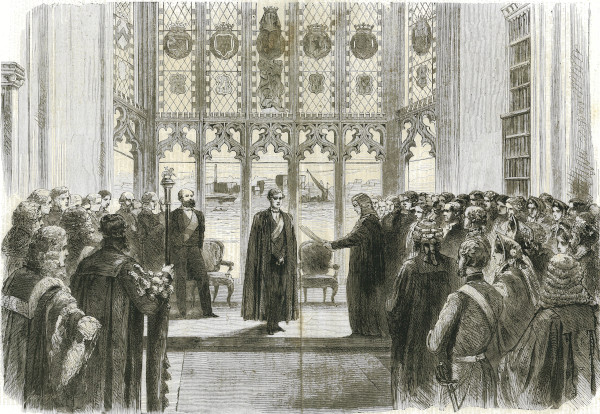
Opening Of The Middle Temple Library By The Prince Of Wales [MT/19/ILL/D/D6/5].
The description of this newly ‘upgraded’ fountain was reported in Bell’s Weekly Messenger described this newly ‘upgraded’ fountain on 12 October 1861, stating that it was “about 12 feet high, being erected on the top of a stone plinth from the bottom of the basin, and consist of a pyramid containing three basins or cups raised one above the other, with carved Corinthian and composite pillars, the upper cup in which the jet is placed being supported by carved figures of children, and altogether the design is exceedingly chaste and well chosen.” The opening ceremony was conducted by the Prince of Wales, and the fountain was illuminated by electric lights as part of the event.
Nevertheless, not everyone was happy with this new, more elaborate design. John Duke Coleridge stated in a letter that he bitterly regretted the loss of the “beautiful unpretending little squirt of a fountain which really way…very sweet in my eyes.” But it was not long until the fountain was redesigned in 1878. A set of square railings and water plants were added along with stone cranes to support the basin, but by 1894 these had broken and been removed.
Later, in 1919, Lord Coleridge, son of the aforementioned John Duke Coleridge, restored the fountain to its original, more simplistic design, removing the elaborate basin and decorative plants/rock, which would no doubt have pleased his father. Even so, this move gained mixed reactions, with one paper stating that it caused “a sharp division of opinions.” One particularly affected group were the birds of the Temple who “lost the bathing and drinking resort to which they have been accustomed” and it was noted that the “birds pub has gone dry with the removal of the rockery and basin.”
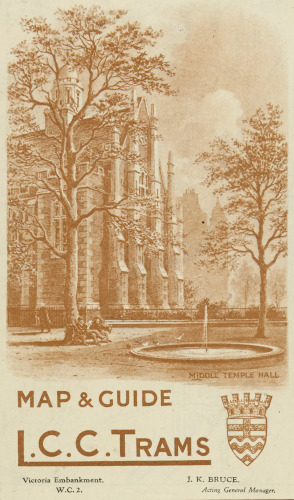
Middle Temple Hall - Map & Guide L.C.C. Trams, 1930 [MT/19/ILL/D/D1/26].
During the Second World War, there was a need for access to water supplies in order to put out fires. Due to this, the fountain was turned into a reservoir for use by the National Fire Service, established in 1941 by the Home Secretary and maintained by the national exchequer. A letter to the Middle Temple on 29 April 1941 shows that orders were given for Dove Bros Ltd to construct a 14-foot wall around the ‘ornamental pond’, the cost of which was to be borne by the council. The image below shows the construction of this reservoir.
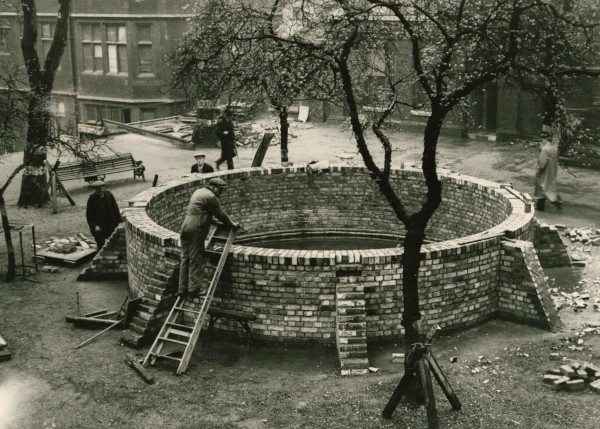
Middle Temple Fountain as a reservoir, 1941 [MT/19/PHO/10/14/3].
In the 2000’s, the Fountain Court Millennium Project took place. Part of this involved work to the fountain which was renovated with new pumps and a nozzle to return the jet to a height of 15-20 feet, with a device that adjusted the height to suit wind conditions. Today the fountain is a peaceful place for members and tourists to walk or admire the water from a bench within Fountain Court.
The Temple fountain has also earned its place in the arts, being used as inspiration by many writers and poets over the years. One example is Charles Dickens, who was admitted to the Inn in 1839 and – although he was never Called to the Bar and withdrew in 1855 – spent much time in and around the Inn, featuring it frequently as a setting in his works. Dickens made several references to the fountain in his book Martin Chuzzlewit, and memorably described it thus: “merrily the tiny fountain played, and merrily the dimples sparkled on its sunny face…softly the whispering water broke and fell; and roguishly the dimples twinkled.”
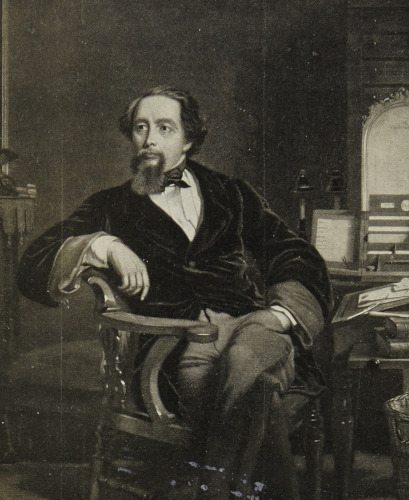
Portrait of Charles Dickens [MT/19/POR/196].
The poet Arthur Symons who, although never a member of the Inn, lived in Fountain Court, went so far as to write a poem which included reference to the fountain:
In Fountain Court
The fountain murmuring of sleep
A drowsy tune;
The flickering of leaves that keep,
The light of June;
Peace through a slumbering afternoon,
The peace of June.
Alongside Symons in Fountain Court also lived William Butler Yeats. He was an Irish poet, one of the foremost figures of 20th Century literature and produced many famous works such as The Second Coming and Lake Isle of Innisfree. Yeats was very fond of the fountain, and once said in letter to his sister Lilly in 1896 that “I have never liked London, but London seemed less disagreeable when one could walk in quiet empty spaces after dark, and upon a Sunday morning sit upon the margin of a fountain almost alone as if in the country.”
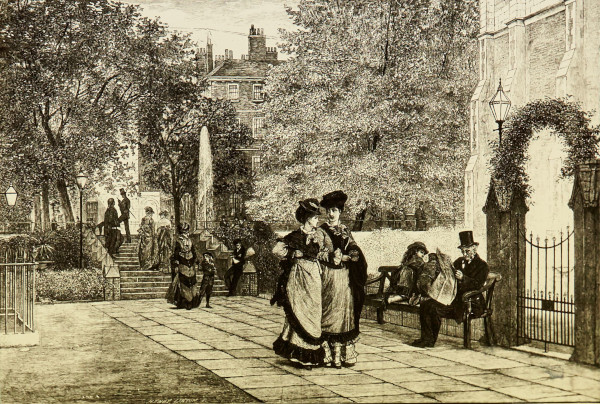
Garden Court with the Fountain in the background [MT/19/SLI/1].
Since 1681, the Middle Temple Fountain has been a key fixture in the Inn’s grounds, providing a sanctuary from the busy world of London which has been a haven of relaxation for members, a source of inspiration for literary figures, and a place of refreshment for wildlife. Having withstood endeavours to remove it and undergone a multitude of redesigns the fountain will, no doubt, stand strong for many centuries to come.